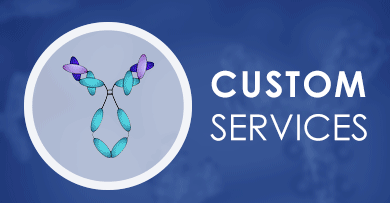 Loading...
Loading...

ACHE
 Loading...
Loading...Anti-ACHE Products
- Recombinant Anti-human ACHE Antibody (MOB-31)
-
- Derivation: Mouse
- Species Reactivity: Human
- Type: IgG
- Application: ELISA, WB, FuncS
-
- Derivation: Human
- Species Reactivity: Human
- Type: IgG
- Application: FC, ELISA, FuncS
- Mouse Anti-AChE Recombinant Antibody (clone AE-2) (VS-0423-XY7)
-
- Species Reactivity: Human
- Type: Mouse IgG
- Application: ELISA, WB
- Mouse Anti-AChE Antibody (clone mAb408), mRNA (PABZ-040-mRNA)
-
- Species Reactivity: Electric eel
- Human Anti-AChE Antibody (clone PD-c-hASP), mRNA (NS-002CN-mRNA)
-
- Species Reactivity: Human
-
- Derivation: Mouse
- Species Reactivity: Human, Mouse, Rat
- Type: Mouse IgG1
- Application: WB
-
- Type: Mouse IgG1
- Application: ELISA, WB, IHC, FC
- Human Anti-AChE Recombinant Antibody (clone WZ1-14.2.1) (VS-0623-WK80)
-
- Species Reactivity: Electrophorus electricus
- Type: Human IgG
- Application: ELISA, Acetylcholinesterase Assay
- Mouse Anti-AChE Recombinant Antibody (clone AE-1) (VS-0423-XY6)
-
- Species Reactivity: Human
- Type: Mouse IgG
- Application: ELISA, WB
- Mouse Anti-AChE Antibody (clone mAb410), mRNA (PABL-024-mRNA)
-
- Species Reactivity: B. fasciatus
- Mouse Anti-AChE Antibody (clone Fab408), mRNA (PABL-374-mRNA)
-
- Species Reactivity: Human
- Mouse Anti-AChE Antibody (clone Fab410), mRNA (PABL-375-mRNA)
-
- Species Reactivity: B. fasciatus
-
- Derivation: Mouse
- Species Reactivity: Electric eel
- Type: IgG
- Application: BL
-
- Derivation: Mouse
- Species Reactivity: Human
- Type: Mouse IgG
- Application: WB, ELISA, FuncS
-
- Derivation: Mouse
- Species Reactivity: B. fasciatus
- Type: IgG
- Application: WB, ELISA, FuncS
-
- Derivation: Mouse
- Species Reactivity: Human
- Type: Mouse IgG
- Application: WB, ELISA, FuncS
-
- Derivation: Mouse
- Species Reactivity: B. fasciatus
- Type: IgG
- Application: WB, ELISA, FuncS
- Mouse Anti-ACHE Recombinant Antibody (clone 23C5) (MOB-0410MZ)
-
- Species Reactivity: Human
- Type: Mouse IgG1
- Application: ELISA, WB
- Mouse Anti-ACHE Recombinant Antibody (clone ZR3) (NEUT-004CQ)
-
- Species Reactivity: Human, Rat, Cat, Guinea pig, Rabbit
- Type: Mouse IgG2b
- Application: Block, IF, IHC, IP
-
- Derivation: Mouse
- Species Reactivity: Human
- Type: Mouse scFv
- Application: WB, ELISA, FuncS
-
- Derivation: Mouse
- Species Reactivity: B. fasciatus
- Type: scFv
- Application: WB, ELISA, FuncS
-
- Derivation: Mouse
- Species Reactivity: Electric eel
- Type: IgG
- Application: BL
-
- Derivation: Mouse
- Species Reactivity: Electric eel
- Type: scFv
- Application: BL
-
- Derivation: Mouse
- Species Reactivity: Human
- Type: Mouse scFv
- Application: WB, ELISA, FuncS
-
- Derivation: Mouse
- Species Reactivity: B. fasciatus
- Type: scFv
- Application: WB, ELISA, FuncS
-
- Derivation: Mouse
- Species Reactivity: Human
- Type: Mouse Fab
- Application: WB, ELISA, FuncS
-
- Derivation: Mouse
- Species Reactivity: B. fasciatus
- Type: Fab
- Application: WB, ELISA, FuncS
-
- Derivation: Mouse
- Species Reactivity: Human
- Type: Mouse Fab
- Application: WB, ELISA, FuncS
-
- Derivation: Mouse
- Species Reactivity: B. fasciatus
- Type: Fab
- Application: WB, ELISA, FuncS
-
- Derivation: Phage display library
- Species Reactivity: Human
- Type: Human IgG
- Application: WB, ELISA, FC, IP
-
- Derivation: Phage display library
- Species Reactivity: Human
- Type: Human Fab
- Application: WB, ELISA, FC, IP
-
- Derivation: Phage display library
- Species Reactivity: Human
- Type: Human scFv
- Application: WB, ELISA, FC, IP
- Recombinant Human Anti-human ACHE Antibody Fab Fragment (MHH-31-F(E))
-
- Derivation: Human
- Species Reactivity: Human
- Type: Fab
- Application: WB, IHC, FuncS
- Recombinant Human Anti-human ACHE Antibody scFv Fragment (MHH-31-S(P))
-
- Derivation: Human
- Species Reactivity: Human
- Type: scFv
- Application: ELISA, IF, FuncS
- Recombinant Anti-human ACHE Antibody Fab Fragment (MOB-31-F(E))
-
- Derivation: Mouse
- Species Reactivity: Human
- Type: Fab
- Application: WB, FuncS
- Recombinant Anti-human ACHE Antibody scFv Fragment (MOB-31-S(P))
-
- Derivation: Mouse
- Species Reactivity: Human
- Type: scFv
- Application: ELISA, WB, FuncS
-
- Species Reactivity: Human
- Target: ACHE
- Host Animal: Human
- Application: ELISA, FC, Cell-uptake
- Anti-ACHE Immunohistochemistry Kit (VS-0525-XY74)
-
- Species Reactivity: Human
- Target: ACHE
- Application: IHC
- Anti-Mouse ACHE Immunohistochemistry Kit (VS-0525-XY75)
-
- Species Reactivity: Mouse, Rat
- Target: ACHE
- Application: IHC
-
- Species Reactivity: Mouse
- Type: Rabbit IgG
- Application: ELISA
Can't find the products you're looking for? Try to filter in the left sidebar.Filter By Tag
Our customer service representatives are available 24 hours a day, from Monday to Sunday. Contact Us
For Research Use Only. Not For Clinical Use.
Background
Blood group antigen proteins, Enzymes, FDA approved drug targets, Metabolic proteins
Intracellular, Membrane (different isoforms)
Cell type enhanced (Paneth cells, Distal enterocytes, Horizontal cells, Proximal enterocytes, Exocrine glandular cells, Erythroid cells)
Not detected in immune cells
Cell line enhanced (BEWO, CACO-2, K-562, Karpas-707, U-2 OS)
Interacts with PRIMA1. The interaction with PRIMA1 is required to anchor it to the basal lamina of cells and organize into tetramers (By similarity). Isoform H generates GPI-anchored dimers; disulfide linked. Isoform T generates multiple structures, ranging from monomers and dimers to collagen-tailed and hydrophobic-tailed forms, in which catalytic tetramers are associated with anchoring proteins that attach them to the basal lamina or to cell membranes. In the collagen-tailed forms, isoform T subunits are associated with a specific collagen, COLQ, which triggers the formation of isoform T tetramers, from monomers and dimers. Isoform R may be monomeric.
Blood group antigen, Hydrolase, Serine esterase



